The best soundbars of 2023: the best, tried-and-true choices for every budget
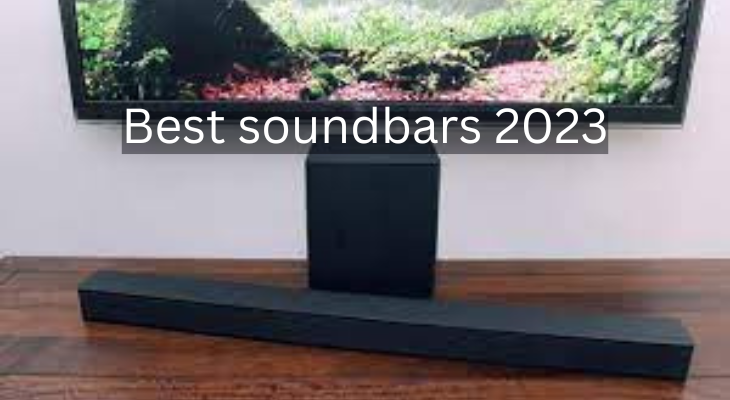
Soundbars are widely accessible in a wide range of sizes and price points, and they are often very simple to install and maintain. The height channels of an Atmos soundtrack are delivered by upward-firing drivers in many mid-range and premium soundbars, which also support Dolby Atmos for a more immersive presentation. Another relatively new feature that makes it simple to transfer immersive audio formats between TVs and soundbars is eARC HDMI connectivity. If these qualities are crucial to you, look for these specifications in our selections below. If not, check out our section on “how to choose a soundbar” below for further considerations.
Table of Contents
ToggleA soundbar: what is it?
A soundbar is a long, narrow speaker system designed to sit beneath or above your TV. It combines multiple speakers in a single enclosure to create a wider soundstage than your TV’s built-in speakers, improving the audio quality for your movies, shows, music, and games.
Here are some key features of a soundbar:
- Multiple speakers: Unlike a single TV speaker, soundbars typically have multiple drivers dedicated to different frequencies (high, mid, and low). This creates a richer and more immersive soundscape.
- Compact design: Soundbars are much smaller than traditional surround sound systems, making them ideal for smaller living spaces.
- Easy setup: Most soundbars connect to your TV with a single HDMI cable, making them much easier to set up than traditional surround sound systems.
- Additional features: Some soundbars offer additional features like Dolby Atmos or DTS:X surround sound technology for a more immersive experience, Bluetooth connectivity for wireless streaming, and voice assistant compatibility for hands-free control.
The Best soundbars of 2023:
Our selections for the top soundbars on the market right now are shown below. You can trust our buying advise since every one has been put to the test by our team of product specialists to ensure it delivers exceptional performance and value.
The Sony HT-A7000
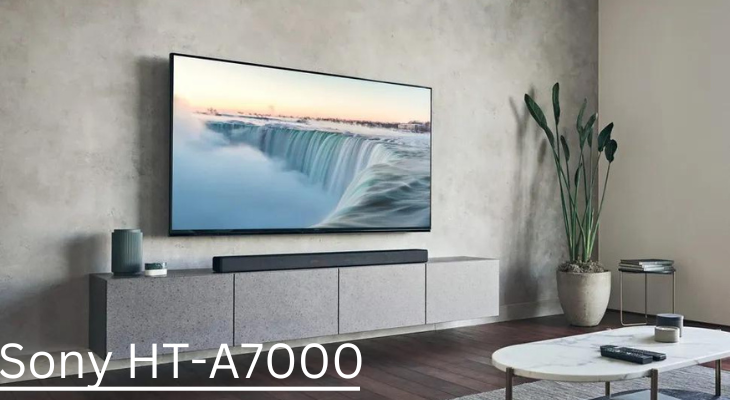
A flagship soundbar that’s ready to blow your mind is the Sony HT-A7000.
Alright, let’s get down to the nitty-gritty! We’re shining the spotlight on the Sony HT-A7000, a premium soundbar that demands attention with its sleek design, cutting-edge technology, and sonic prowess that could make even the most jaded audiophile weak in the knees.
- First Impressions: This isn’t your average soundbar. The HT-A7000 oozes sophistication, with a minimalist design that wouldn’t look out of place in a museum of modern art. It’s a blend of textures and materials, from the luxurious fabric covering the upward-firing drivers to the sleek metal grille and the smooth glass top. This isn’t just a soundbar; it’s a statement piece for the discerning audio enthusiast.
- Sound that Will Shake Your Walls (But Not Your Neighbors): But let’s be honest, you’re not buying this for its looks (although, let’s face it, they’re pretty darn impressive). The HT-A7000 packs a serious punch when it comes to sound. We’re talking Dolby Atmos and DTS Virtual X that make you feel like you’re literally living inside the movie. Explosions erupt around you, whispers seem to come from behind the couch, and car chases weave through your living room like a sonic rollercoaster. It’s truly immersive, and it’s the kind of experience that makes you forget you’re even watching TV.
- Tech Specs that Impress: Don’t worry, the HT-A7000 isn’t just about hype. It’s backed by some serious tech muscle. We’re talking 7.1.2 channel audio with upward-firing drivers that bounce sound off your ceiling for that true Atmos effect. Plus, there’s Sony’s own 360 Spatial Sound Mapping technology that analyzes your room and adjusts the soundstage accordingly. No more sweet spots – the whole room becomes a sonic paradise.
- But Wait, There’s More: The HT-A7000 isn’t a one-trick pony. It’s packed with features like HDMI 2.1 ports for future-proofing, eARC compatibility for lossless audio, and Bluetooth and Wi-Fi connectivity for streaming your favorite tunes. Oh, and did we mention it can be expanded with a subwoofer and rear surround speakers for an even more epic experience? This is a soundbar that grows with you, adapting to your evolving home theater needs.
- The Bottom Line: The Sony HT-A7000 isn’t just a soundbar; it’s an investment in your home theater dreams. It’s a statement piece, a sonic marvel, and a future-proofed powerhouse that will elevate your TV experience to a whole new level. If you’re serious about sound, and your budget allows, this is the soundbar that should be at the top of your list. Just be prepared to pick your jaw up off the floor after your first movie night.
Sonos Ray:
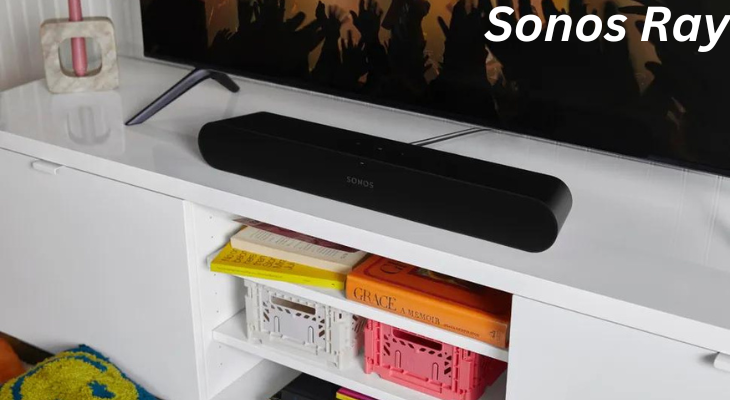
Move over, bulky soundbars! The Sonos Ray is here to prove that big things can come in compact packages. This sleek little soundbar packs a surprising punch, making it the ideal choice for those who want to upgrade their TV sound without sacrificing precious space or breaking the bank.
- Small but Mighty: Don’t let the Ray’s diminutive size fool you. This soundbar is just 23 inches wide and barely over 2 inches tall, making it perfect for smaller living rooms, bedrooms, or even dorm rooms. But despite its size, the Ray delivers crystal-clear sound with remarkable clarity for dialogue and vocals. You’ll finally be able to hear every whispered word in your favorite shows and movies without cranking up the volume.
- Simple Setup, Seamless Experience: Sonos is known for its user-friendly technology, and the Ray is no exception. Setup is a breeze, taking just a few minutes with the Sonos app. You’ll be enjoying your upgraded sound in no time. Plus, the Ray integrates seamlessly with the Sonos ecosystem, so you can easily add it to your existing Sonos setup or build your multi-room audio system around it.
- Sound Beyond its Size: While the Ray may not have all the bells and whistles of its bigger Sonos siblings, it still delivers surprisingly immersive sound. It uses Dolby Atmos virtualized surround sound to create a wider soundstage, making you feel like you’re right in the middle of the action. And despite its lack of dedicated bass drivers, the Ray produces clear and punchy low-end tones that are perfect for movies, music, and even gaming.
- Budget-Friendly Bliss: Let’s face it, soundbars can be expensive. But the Ray is a breath of fresh air for budget-conscious audiophiles. Priced at around $279, it’s significantly cheaper than most high-end soundbars, making it an accessible option for everyone.
- The Verdict: The Sonos Ray is a no-brainer for anyone looking for a compact, affordable, and easy-to-use soundbar that delivers a significant upgrade over their TV’s built-in speakers. Its small size makes it perfect for smaller spaces, and its clear, immersive sound is sure to impress. Plus, the seamless Sonos integration and budget-friendly price tag make it an even sweeter deal.
So, if you’re looking for a soundbar that punches above its weight without taking up too much space or breaking the bank, the Sonos Ray is definitely worth checking out. You might just be surprised at how much big sound it packs into its tiny frame.
Sonos Beam Gen 2:
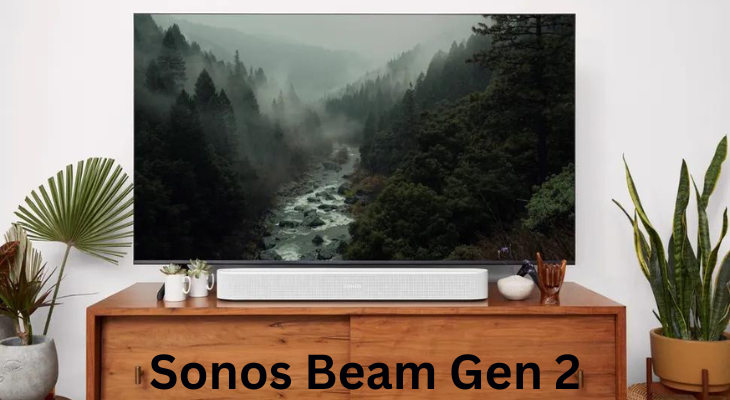
Ah, the Sonos Beam Gen 2. It’s the sweet spot in the Sonos soundbar lineup, balancing impressive sound quality, smart features, and a compact design in a package that hits the mark for many budgets and living spaces. Let’s dive into what makes this soundbar such a popular choice.
- Sleek and Compact:First things first, the Beam Gen 2 is a handsome devil. Its sleek, low-profile design blends seamlessly into any living room aesthetic. At just 39.2 inches wide and 2.7 inches tall, it won’t overpower your TV stand or hog precious space. It’s available in black and white, so you can choose the one that best complements your setup.
- Sound that Surrounds You:But looks aren’t everything, right? The Beam Gen 2 packs a serious sonic punch for its size. It delivers crisp and clear audio across the entire spectrum, from subtle dialogue to booming explosions. Dolby Atmos support throws sound around the room, creating a surprisingly immersive experience for movies and games. It’s not quite true surround sound, but it’s darn close, especially considering the soundbar’s compact footprint.
- Smart and Savvy:The Beam Gen 2 isn’t just about brawn, it’s got brains too. It seamlessly integrates with your smart home ecosystem, letting you control it with your voice through Google Assistant or Apple AirPlay 2. Stream music from all your favorite services, adjust the volume, and even switch inputs, all hands-free. Plus, it plays nicely with other Sonos speakers, allowing you to build a multi-room audio system that fills your entire home with sweet sounds.
- Room for Expansion:If you crave even more sonic punch, the Beam Gen 2 has you covered. You can add a Sonos Sub for some thunderous bass, or rear surround speakers for a truly cinematic experience. It’s a soundbar that can grow with your needs, making it a sound investment for the future.
- The Verdict:The Sonos Beam Gen 2 is a versatile soundbar that strikes the perfect balance between size, sound quality, and smart features. It’s a great choice for anyone looking to upgrade their TV sound without breaking the bank or taking up too much space. Whether you’re a movie buff, a music lover, or just someone who appreciates good sound, the Beam Gen 2 is definitely worth considering.
Bonus Tip:
If you’re looking for something even more compact and budget-friendly, check out the Sonos Ray. It sacrifices some features and soundstage compared to the Beam Gen 2, but it’s still a fantastic option for smaller spaces and tighter budgets.
Sonos Arc:
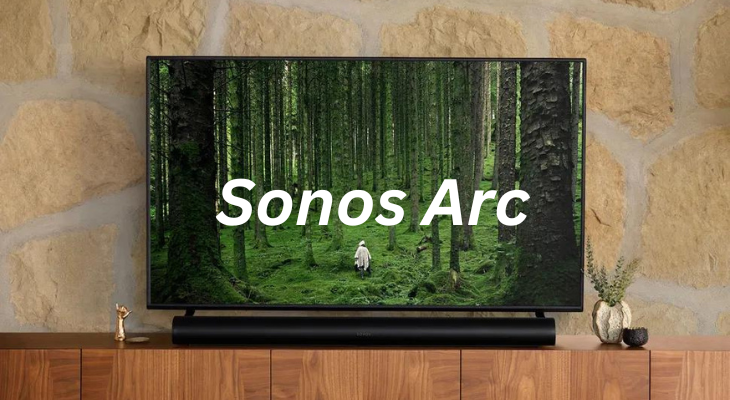
Ready to ditch the “meh” TV sound and step into a sonic sanctuary? The Sonos Arc stands tall as the crown jewel of the Sonos soundbar family, ready to engulf you in a wave of cinematic audio that will leave you breathless. But is it just hype, or does it truly deliver on its promises? Buckle up, audiophiles, because we’re diving deep into the Arc’s majestic world.
- Prepare to Be Wowed:First things first, the Arc isn’t just a soundbar; it’s an experience. Its sleek, elegant design screams sophistication, with smooth curves and premium materials that make a statement without dominating your living room. It’s available in black and white, so you can choose the one that perfectly complements your aesthetic.
- Soundstage fit for a King:Forget wimpy, tinny TV audio. The Arc delivers a symphony of sound that wraps around you like a sonic cloak. Dolby Atmos support isn’t just a checkbox; it’s a portal to another dimension. Planes soar overhead, footsteps dance across the room, and explosions detonate with terrifying realism. You’ll hear details you never knew existed in your favorite movies and shows, and music will take on a whole new life, with instruments weaving a tapestry of sonic joy.
- Crystal Clarity, Punchy Power:But the Arc isn’t just about bombast. Dialogue is crystal clear, even in the most intense scenes. Whispers are audible, voices pierce through the action, and you’ll never miss a crucial line again. And don’t underestimate the bass. While a subwoofer can take it to another level, the Arc packs enough punch on its own to make your walls tremble and your popcorn jump.
- Smart and Savvy:The Arc isn’t just a brainiac in the audio department; it’s a tech whiz, too. Seamless integration with Google Assistant and Apple AirPlay 2 lets you control the sound with your voice or phone. Stream music from any service your heart desires, adjust the volume, and even switch inputs, all hands-free. Plus, it’s the conductor of your Sonos multi-room orchestra, connecting with other Sonos speakers to fill your entire home with sonic bliss.
- Room for Expansion (Literally):For those with insatiable cravings for sonic grandeur, the Arc expands your options. Add a Sonos Sub for bass that will rattle your bones, or surround yourself with Sonos rear speakers for a truly immersive cinematic experience. This soundbar is the foundation for your ultimate home theater dreams, evolving as your needs and budget grow.
- The Verdict:The Sonos Arc isn’t just a soundbar; it’s an investment in your audio future. It’s a premium experience for those who demand the best. While its price tag might make budget-conscious ears wince, the sheer sonic perfection it delivers makes it a worthy splurge for anyone who craves audio immersion that feels like stepping into your favorite movie or concert.
Bonus Tip:
If the Arc’s price tag makes you sweat, consider the Sonos Beam Gen 2 or Sonos Ray. They offer impressive sound quality and smart features at more accessible price points. No matter your budget, there’s a Sonos soundbar waiting to elevate your TV experience.
Sennheiser Ambeo Soundbar Max:
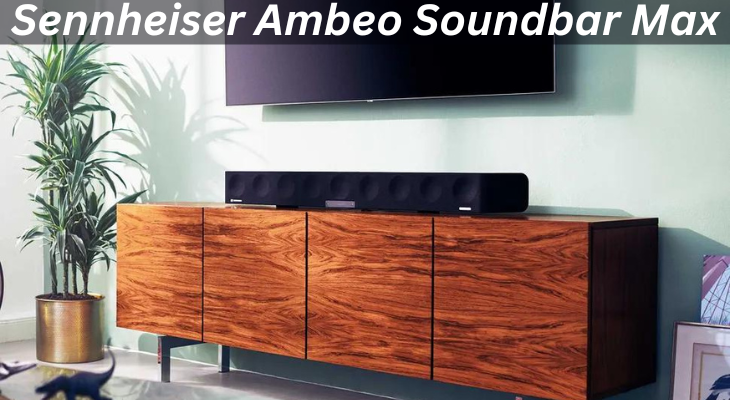
Hold onto your hats, sound enthusiasts, because we’re venturing into the realm of the truly extraordinary with the Sennheiser Ambeo Soundbar Max. This isn’t just a soundbar; it’s a sonic beast ready to unleash aural annihilation (in the best possible way) upon your living room. Buckle up, and let’s dissect this technological marvel.
- Luxury Personified:From the moment you lay eyes on the Ambeo Soundbar Max, you know you’re dealing with something special. Its sleek, minimalist design screams exclusivity, with high-quality materials and a commanding presence that makes it the centerpiece of any home theater. It’s not just functional; it’s a statement piece, whispering luxury to anyone who lays eyes on it.
- Beyond Atmos: Where Sound Takes Flight Ambeo Soundbar Max goes beyond mere Dolby Atmos. It utilizes Sennheiser’s proprietary 3D Sound technology, creating a soundscape so immersive, so real, you might forget you’re still in your living room. Objects fly around you, whispers seem to emanate from thin air, and explosions shake the very foundations of your house (figuratively, of course). It’s not just surround sound; it’s sonic teleportation, transporting you right into the heart of the action.
- Audiophile Dreams Do Come True:But the Ambeo Soundbar Max isn’t just about spectacle; it’s about precision. Crystal-clear dialogue pierces through the most intense scenes, instruments in music shimmer with breathtaking detail, and every nuance of the audio mix is presented with meticulous accuracy. This is a soundbar for discerning ears, for those who crave audio fidelity that leaves no stone unturned.
- Brainpower Meets Brawn:The Ambeo Soundbar Max isn’t just a musclebound brute; it’s a technological savant. It boasts built-in Chromecast and AirPlay 2 for seamless streaming, intuitive app control, and voice assistant compatibility with Google Assistant and Amazon Alexa. Plus, it can be the conductor of your multi-room audio orchestra, linking with other Sennheiser and Sonos speakers to bathe your entire home in sonic splendor.
- The Price of Immersion:Of course, such sonic mastery doesn’t come cheap. The Ambeo Soundbar Max carries a hefty price tag that places it firmly in the luxury category. But for those who demand the absolute best, for those who crave audio experiences that redefine reality, the Ambeo Soundbar Max is an investment worth considering.
- The Verdict:The Sennheiser Ambeo Soundbar Max isn’t just a soundbar; it’s a portal to aural nirvana. It’s a statement piece, a technological marvel, and a sonic weapon of mass pleasure. While its price tag might make some wallets weep, the sheer level of immersion and audio fidelity it delivers is unlike anything most have ever experienced. If you’re an audiophile with deep pockets and a thirst for sonic dominance, the Ambeo Soundbar Max is waiting to unleash its fury.
Sony HT-SF150:
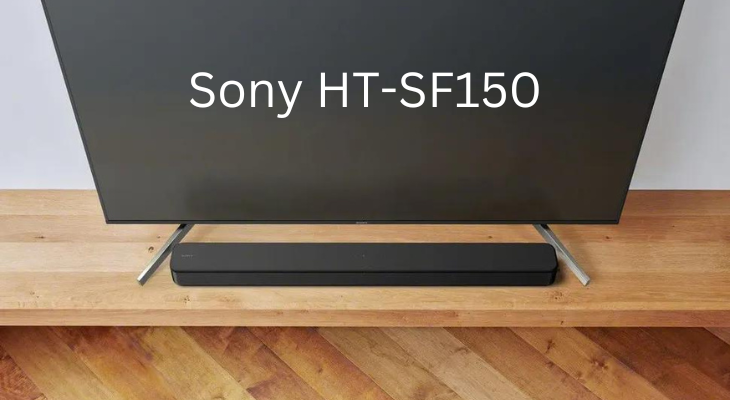
Alright, audio enthusiasts, let’s shift gears and zoom in on the budget-conscious soundbar warriors! The Sony HT-SF150 enters the arena, ready to prove that big sound doesn’t have to come with a big price tag. This compact soundbar is the perfect upgrade for those who want to ditch their TV’s tinny speakers without breaking the bank.
- Mighty Mite: Don’t underestimate the HT-SF150’s size. While it clocks in at a mere 26 inches wide and 2.1 inches tall, it packs a surprising punch when it comes to sound. It delivers clear and crisp audio that’s a significant upgrade over built-in TV speakers, especially for dialogue and vocals. You’ll finally understand every whispered word in your favorite shows and movies, no more cranking the volume!
- Small but Savvy: The HT-SF150 is all about simplicity. Setup is a breeze, taking just a few minutes with the included optical cable. It connects easily to your TV, and you’ll be enjoying your upgraded sound in no time. Plus, it offers Bluetooth connectivity, letting you stream your favorite tunes wirelessly from your phone or tablet.
- Compact Space, Big Sound: The HT-SF150 is ideal for smaller living rooms, bedrooms, or even dorm rooms. Its slim design won’t overwhelm your space, making it a seamless addition to any setup. And while it won’t deliver surround sound or earth-shattering bass, it offers a significant improvement in audio clarity and depth, making your TV shows and movies come alive.
- The Bottom Line: If you’re on a budget and looking for a simple, affordable way to upgrade your TV sound, the Sony HT-SF150 is a fantastic option. It delivers clear audio, is easy to set up, and won’t take up precious space. While it won’t compete with high-end soundbars, it offers a significant and satisfying improvement over built-in TV speakers, making it a great value for the price.
Roku Streambar:
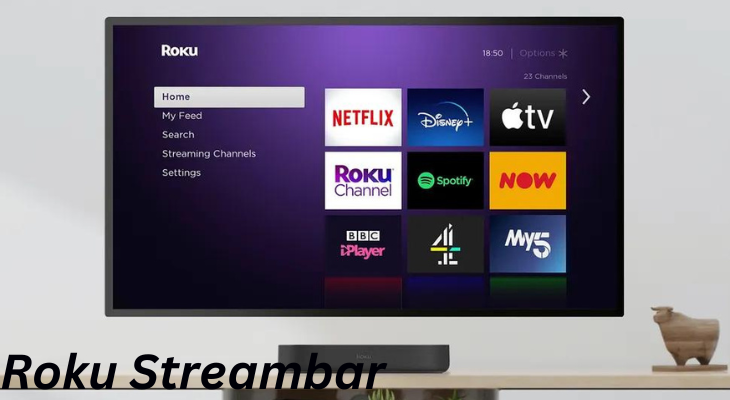
Looking for a simple, affordable way to upgrade your TV sound and get access to all your favorite streaming services? The Roku Streambar is the perfect solution. This all-in-one device combines a soundbar, streaming player, and remote control into a single, compact package.
- Stream Your Favorite Shows and Movies:The Roku Streambar is a great way to upgrade your streaming experience. It comes with access to over 5,000 streaming channels, including Netflix, Hulu, Disney+, Amazon Prime Video, and more. You can also access free, live TV channels with the Roku Channel.
- Upgrade Your TV Sound:The Roku Streambar delivers clear, crisp audio that’s a significant improvement over built-in TV speakers. It features five built-in speakers that create a wide soundstage, making your movies and shows come alive.
- Easy Setup:The Roku Streambar is easy to set up. Simply plug it into your TV’s HDMI port, connect to Wi-Fi, and follow the on-screen instructions. You’ll be streaming and enjoying improved sound in minutes.
- The Verdict:The Roku Streambar is a great option for anyone looking for a simple, affordable way to upgrade their TV sound and streaming experience. It’s a great value for the price, and it’s easy to set up and use.
How to select the best TV soundbar
To determine the exact size of your new soundbar, take into account the measurements of your TV. Though you don’t want it to be overwhelmed by the screen, pairing a small TV with a large bar could look awkward, as if the TV were a tiny head resting on an excessively large shoulder. Check the measurements and see how wide the bar is in relation to your TV. Check the height as well. If the soundbar is going to be placed in front of your TV, make sure it doesn’t block out half of the image. If the soundbar has upward-firing drivers, make sure they have a clear path to your ceiling in order for them to work properly.
Soundbars are often only one long speaker with multiple drivers inside, although some are compatible with other speakers from the manufacturer’s brand, while others have external subwoofers for additional low-end extension and back speakers for surround sound effects. You should think about these models if you’re looking for something with a lot of bass that shakes the floor.
Features and connectivity come next. ARC and eARC-enabled HDMI connectors, which support optical inputs for older TVs as well as high bandwidth multichannel audio codecs, are a common feature of modern TV soundbars. Your current remote control will work to adjust the volume of your soundbar if your TV is equipped with ARC/eARC technology. It’s worth thinking about if you’re comfortable using a smartphone app to adjust the soundbar’s settings or whether you want to have a separate physical remote.
In addition to Bluetooth connectivity, the majority of contemporary soundbars offer some choices for wireless music listening through wifi streaming through services like Airplay 2, Spotify Connect, and Chromecast. Additionally, certain mics come equipped with voice assistant compatibility or capabilities. Look for extra HDMI passthrough connectors to expand the flexibility of your setup if you have any external devices, such as game consoles or a 4K Blu-ray player.
If you want to get a soundbar that creates an immersive home theater experience instead of just a basic TV sound upgrade, you should look into models that support DTS:X and Dolby Atmos audio. Some soundbars incorporate upfiring speakers for height effects, while others accomplish this virtually through processing. If you choose the latter, keep in mind that the soundbar’s top must be exposed and kept away from the TV screen, and that the effect will be more effective if you have low ceilings to reflect the sound off of.
You should confirm that your TV and any prospective soundbar support Dolby TrueHD and eARC if you value excellent 3D sound. Dolby TrueHD can deliver full-fat Dolby Atmos in all its lossless splendor, while the ARC standard can only handle Dolby Atmos in its lossy Dolby Digital Plus form.
Consider the material you want to see and the sources you want to use. Many of these technologies will be unnecessary if you only watch Freeview. Nevertheless, you should maximize the audio quality if you’re streaming 4K HDR material from services like Netflix, Apple TV, and Amazon Prime Video to ensure that your content sounds as amazing as it looks. See our comprehensive guide on selecting and configuring a soundbar for a comprehensive rundown.
We’ve compiled the top soundbars for different price ranges here; if you’re specifically searching for a model that’s very reasonable, see our best budget soundbars page. If you’d like a Dolby Atmos soundbar, we also have a page just for that. We believe that all of the models we’ve suggested will improve your audio experience with a hassle-free setup, regardless of your budget.
How soundbars are tested
Our staff of skilled, in-house reviewers tests most hi-fi and AV equipment that comes through our door in our state-of-the-art testing facilities in London, Reading, and Bath. We give them lots of listening time and run them in before we start reviewing.
Every soundbar we evaluate is matched with a suitable reference TV and put up against the finest in its price and feature class, be it the winner of the What Hi-Fi? award right now or some of the newest models that have impressed us in previous evaluations. Comparative testing is the foundation of What Hi-Fi?, and we maintain industry-leading items in our stockrooms to provide the easy comparison of new products with beloved models.
We always strive to be objective and to ensure that we’re seeing every product at its finest, so we’ll watch a wide variety of movies and TV series that showcase the capabilities of each soundbar in both high-end and mainstream audio formats. For instance, if the soundbar has Dolby Atmos, we will test its Dolby True HD performance using Blu-ray discs, but we will also use streaming services that use Dolby Digital Plus to see how well it performs.
While most soundbars are made with cinema and television in mind, we also test them with music, trying out a number of streaming services that offer a wide range of genres—both contemporary and classic—ensuring that we listen in the best quality possible.
Our reviews are divided into three categories: design, features, and sound. To ensure that we’re being as thorough as possible and to remove any personal preferences, the crew as a whole agrees on all decisions rather than just one reviewer. Regarding the decision, neither our sales team nor PR firms have any say. What Hi-Fi? is happy to have provided objective, truthful reviews for many years.
FAQs
Do TV speakers perform better than soundbars?
Soundbars are thin, frequently rectangular speaker systems that may be neatly mounted to the wall or tucked under your TV. They have drivers placed side by side. Even entry-level, low-cost soundbars with front-facing drivers usually provide more direct and clear audio than a TV.
This is due to the fact that as TVs have gotten thinner, their built-in speakers have also gotten smaller and are sometimes placed underneath or in the back of the screen. These locations are not ideal because big speakers facing forward will always sound clearer and be louder than tiny speakers facing the other way.
With differing degrees of success, manufacturers have attempted to improve the audio output from their televisions. However, you will need a separate speaker made specifically for that reason if you want to enhance TV audio.
There are several inexpensive to expensive ways to enhance the sound quality of your TV, but a soundbar is one of the easiest because they are usually small and require less cable. They frequently offer further advantages as well, such Bluetooth or WiFi wireless streaming.
Can a soundbar be installed on any TV?
Any soundbar or TV, regardless of age, will almost always include an optical connection, and many of them will also support ARC and, in particular, eARC, which debuted with HDMI 2.1 in 2017 and has since gained popularity. Consider the benefits and drawbacks of each option before choosing how to connect your devices to your TV. Make sure the cable you require is included in the soundbar’s box.
Which is preferable for a soundbar, optical or ARC?
The first important thing to understand about optical is that, in contrast to ARC/eARC, its bandwidth is limited. You may not be taking full advantage of your soundbar’s audio decoding capabilities if you choose optical over the other option. Dolby Atmos or DTS:X are not supported since compressed Dolby Digital or DTS 5.1 surround sound are the most sophisticated immersive formats that optical devices can handle.
Make sure your TV has an HDMI connector that can support all of the audio formats being transmitted to it before using ARC or eARC. For a detailed explanation of this connection, see our guide to HDMI ARC and HDMI eARC. However, keep in mind that while eARC is capable of handling high-quality codecs like Dolby Atmos in Dolby TrueHD, DTS-HD Master Audio, or DTS:X, ARC only supports Dolby Atmos in its lossy Dolby Digital Plus format, which is the codec used by streaming services. To get the most out of your system, you should definitely make sure you have an eARC connection if you are watching or playing games that require physical media.
Additionally, ARC/eARC enables basic volume and power management of your soundbar via HDMI CEC (Consumer Electronics management) with your primary TV remote. If your TV is connected to your home via an optical cable, you could still be able to use your standard controller even if some soundbars come with their own remotes and/or app control. A TV manufacturer’s setup instructions will determine which models, like the Sonos Ray and B&W Panorama 3, can ‘learn’ to identify commands from both IR and RF remotes.
Unfortunately, depending on your TV-soundbar combination, ARC/eARC might occasionally cause a little audio latency that causes lipsynching problems. On the app for a soundbar, many companies do, however, offer controls to change the delay; occasionally, the TV’s settings also offer this feature.
Verify that you are truly receiving Dolby Atmos if you are connecting to a Dolby Atmos soundbar via ARC/eARC. The majority of soundbar apps will confirm the kind of audio file you are presently listening to, either on the Now Playing page or sporadically on the display of the soundbar (if it has one). It is therefore time to check the settings on your TV and Blu-ray player if the content you are watching is supposed to be in Dolby Atmos but the app indicates otherwise (probably ‘PCM’, ‘5.1’, or ‘2.0’).
Any source device needs to be configured to produce bitstream audio in order to receive Dolby Atmos. This option is available in TVs, Blu-ray players, and streaming sticks’ audio settings. PCM only allows you to hear audio in stereo; however, transmitting bitstream enables your soundbar to receive all of the beautiful Dolby formats, including Atmos.
Which soundbar equalization settings work best?
Make sure to use any auto-calibration software that your soundbar may have if it has one so that the audio output is adjusted to your room’s specifications. For example, the Sonos Arc adjusts its sound using the microphone on your smartphone and Sonos’s Trueplay software.
Even better than automated optimization are your own ears. If your soundbar allows you to adjust the volumes of each individual channel, don’t be afraid to make adjustments to fit your preferences or requirements. Due to individual differences in hearing, what sounds good to one person may not sound good to another. A soundbar’s greatest feature is that, in most cases, it’s very easy to alter and swap back if you change your mind.
Certain soundbars will have preset settings for certain kinds of media. According to our observations, “spatial” processing—which might create high-frequency artifacts—is frequently used by soundbars with cinematic settings. Conversely,’music’ modes typically feature an EQ that is heavily focused on the bass and treble, giving it a somewhat brazen feel. If a flat standard option is available, we usually prefer it and manually tweak it to our preferences. However, there isn’t a single strategy that works for every setting and listener.
Nothing is more annoying than being unable to hear dialogue when watching a TV show or movie, but even the best, room-tuned soundbars can be hampered by whispery, mumbly vocals due to a variety of factors, including speech clarity, volume, and mix style.
Thankfully, most soundbars provide speech enhancement feature settings that may be used to boost dialogue audibility. These settings usually include turning up the center channel’s volume and sharpening the EQ. Again, it’s worth experimenting to find what suits you and your space—not every manufacturer does this elegantly, and occasionally these modes can sound harsh and cheap.



